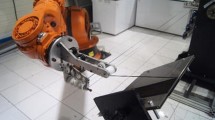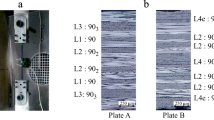Abstract
The failure process in waisted tensile specimens of pultruded 60% volume fraction carbon fibre-epoxide was investigated at atmospheric and superposed hydrostatic pressures up to 300 MN m−2. The maximum principal stress at fracture decreased from ~ 2.0 GN m−2 at atmospheric pressure to ~ 1.5 GN m−2 by 200 MN m−2 superposed pressure and then remained approximately constant. These latter failures were fairly flat and no damage preceding the catastrophic fracture was detected, which indicates that composite strength is solely controlled by fibre strength. Fracture of fibres at lower pressures appeared to commence also in the range 1.5 to 1.6 GN m−2, but, as it did not result in catastrophic failure, account has to be taken of the resin and the fibre bundles. Debonding was initiated at ~ 1.2 GN m−2 at atmospheric pressure and this stress increased to ~ 1.5 GN m−2 when 150 MN m−2 superposed pressure was applied; the pressure dependence was related to that of the resin tensile strength. This process is described as the first stage, straightening and debond initiation of curved surface bundles, on our model of tensile failure. The second stage, delamination, i.e. the growth of transverse cracks leading to the detachment of these bundles, was impeded by the transverse pressure, being suppressed beyond 150 MN m−2. Only below this pressure was load redistribution between bundles possible, but, as the pressure was increased from atmospheric, it become more difficult, resulting in a decrease in the composite tensile strength and reduced fibre pull-out.
Similar content being viewed by others
References
M. Fuwa, A. R. Bunsell andB. Harris,J. Mater. Sci. 10 (1975) 2062.
M. Fuwa, B. Harris andA. R. Bunsell,J. Phys. D. 8 (1975) 1460.
A. R. Bunsell andD. Valentin,Compos. Struct. 1 (1983) 67.
C. Zweben andB. W. Rosen,J. Mech. Phys. Solids 18 (1970) 189.
D. G. Harlow andS. L. Phoenix,J. Compos. Mater. 12 (1978) 195.
B. W. Rosen,Amer. Inst. Aeronaut. Astronaut. J. 2 (1964) 1985.
A. S. Wronski andT. V. Parry,J. Mater. Sci. 19 (1984) 3421.
B. R. Watson-Adams, J. J. Dibb andA. S. Wronski, Metal Matrix Composite Materials, November 1972, Liverpool Polytechnic Symposium, edited by R. W. Jones, paper 4.
A. S. Wronski, Proceedings of the Third International Conference on Fracture, Munich, 1973, II-332.
J. J. Dibb, PhD thesis, University of Bradford (1975).
J. J. Dibb, A. S. Wronski andB. R. Watson-Adams,Composites 4 (1973) 227.
R. L. McCullough, “Concepts of Fibre-Resin Composites” (Marcel Dekker, New York, 1971) p. 46.
A. Cuckson, Materials Science Undergraduate Project Report, University of Bradford (1983).
D. G. Swift,J. Phys. D. 8 (1975) 223.
A. S. Wronski andM. Pick,J. Mater. Sci. 12 (1977) 28.
A. S. Wronski andT. V. Parry,ibid. 17 (1982) 3656.
A. Kelly andG. J. Davies,Metall. Rev. 10 (1965) 1.
J. W. Hitchon, W. H. McCausland andD. C. Phillips, AERE Report R8217 (1975).
J. W. Hitchon andD. C. Phillips, AERE Report R9132 (1978).
T. V. Parry andA. S. Wronski,J. Mater Sci. 17 (1982) 893.
Author information
Authors and Affiliations
Rights and permissions
About this article
Cite this article
Parry, T.V., Wronski, A.S. The effect of hydrostatic pressure on the tensile properties of pultruded CFRP. J Mater Sci 20, 2141–2147 (1985). https://doi.org/10.1007/BF01112298
Received:
Accepted:
Issue Date:
DOI: https://doi.org/10.1007/BF01112298




